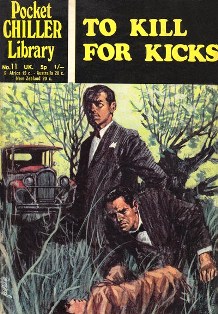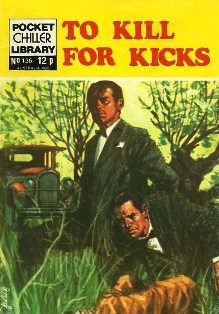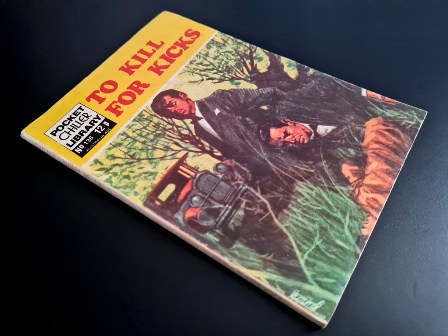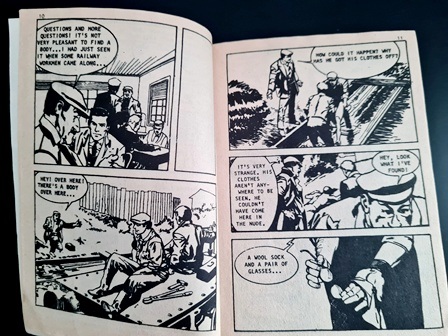
Originally Published In Issue 11

Reprinted In Issue 136
First published back in June of 1971, Issue 11 of the ‘Pocket Chiller Library’ comic series was titled ‘To Kill For Kicks’. The comic was later reprinted under the same title within Issue 136 forming the penultimate reprinted PCL issue.
During the 1970s the ‘Pocket Chiller Library’ was a pocket-sized mainstream horror comic which ran for a total of 137 issues between 1971 and 1977. Each month, two issues of the comic were published, amounting to a total of twenty-four issues of the comic published each year.
However, it should be noted that issue 83 and then from issue 86 onwards, the publishers started reprinting the earlier stories. Of these reprints, the first 29 reprints (issues 83 and then 86 – 113) retitled the story. As such, there were only ever a total of 84 unique stories within the series, despite there being more titles.
Unfortunately, each issue was undated, making it difficult to be sure of the date for first publication of each issue. However, it is widely understood the comics were monthly publications, with two publications released simultaneously each month, with the original stories running from January 1971. Therefore, the above date of publication is a relatively reasonable assumption.
Additionally, each issue was unfortunately uncredited to either the writer or the comic artist(s).
Early in the morning, the body of a fourteen-year-old boy was found floating in a stream beside the railway line running through Hegewisch. The young boy was naked, lying face down in the water, his face burned away with acid.
Meanwhile, the parents of Bobby Franks had been getting worried about their missing son. Their increasing concern was to become justified, when they receive a telephone call from a man pertaining to be Harry Williams. The call is short but direct. If they want to see their son again, they must follow the kidnapper’s instructions. Demands which will arrive in a letter shortly.
The next day a letter arrives informing them to obtain ten thousand dollars in used notes. The kidnapper would call again with further instructions.
But news of the discovery of the boy’s body had already made it to those helping Mr and Mrs Franks. Despite the couple’s denial about the body being their son’s, the police a certain of the connection.
The police had started pulling together a trail of haphazard clues. A grey Winton car had been seen picking Bobby up from school on that fateful day. A pair of broken spectacles and a wool sock had also been discovered in the vicinity of the boy’s body.
The local reporters had been hot on the case. But things weren’t adding up for either the police or the reporters. Why kill the boy before retrieving the ransom? Why give the name of Harry Williams on the telephone calls? All of the details were pointing to a sadist. The police just had to figure out why and then who…
DLS Review:
Here we have the true crime story of Nathan Leopold and Richard Loeb’s murder of 14-year-old Bobby Franks from back in 1924. For the PCL comic, the murderer’s names have been changed to George Stills and Dickie Koles, however many of the facts remain largely correct.
The Leopold and Loeb case is a well-known example of a "thrill killing", in which the motive for the brutal murder was purely for the thrill of it – or as described in the comic, to set the two wealthy young men truly free from the constraints of society.
The comic starts off with the discovery of Bobby Franks’ mutilated body, whereupon the story swiftly moves to the kidnapper’s demands. After the first phone call to the Franks family home, a large part of the comic is given over to the investigation, with both the police and the local reporters doing what they can to uncover the identity of the killer.
It’s a very 1920s Chicago crime investigation style of story, with the clues leading the police and reporters on a wild goose chase, with a huge sway of the suspicion resting on the wealthy eccentric Harry Williams. However, the arrival of George Stills and Dickie Koles into the picture starts to make things more interesting.
If you’re not familiar with the case, then it delivers a relatively interesting whodunnit plot. Although due to the brevity of the comic format, many of the clues are condensed and seem almost erratic in nature. In fact, they are, and that’s what really puzzled the police at the time!
It’s however, not exactly a ‘chiller’ but more a true crime mystery. Although the revelation of the pair’s dark motive for such a heinous crime is pretty grim to say the least. But with so much of the comic spent chasing after the clues and questioning of possible witnesses, it’s not really what the PCL stories became all about.
That said, it’s still an entertaining and somewhat compelling read.
The comic book runs for a total of 64 pages.

© DLS Reviews







